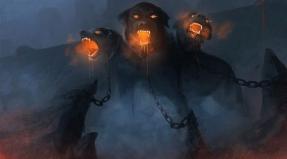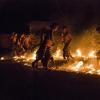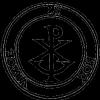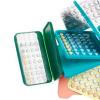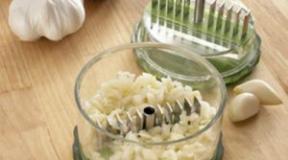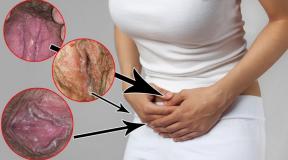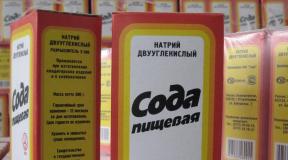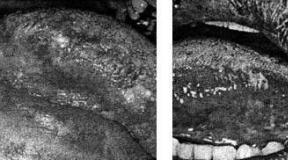Do-it-yourself shelf for an icon. Do-it-yourself corner shelf for icons. Icons for home iconostasis
A feature of the do-it-yourself shelf for icons is that it should not be wall-mounted, but angular, since the icons are supposed to be placed in the eastern corner of the brightest and largest room.
You can make a shelf for icons from a board, chipboard, thick plywood. You can also use old wooden shelves, window sills, or countertops for this purpose, such as the desk top that your son or daughter once studied at.
And you can buy a suitable board at a hardware store.
Single-tier rack from a purchased board
Tools and materials:

- a board made of pine, cherry or walnut 3 cm thick;
- dowels - 4 pcs.;
- wood saw;
- pencil;
- ruler;
- sandpaper;
- wood paint;
- wood varnish;
- brackets or brackets for mounting;
- 4 landscape sheets;
- tape or sticky notes.
Determine the size of the corner shelf you need (for example, the width is 420 mm, and the sides are 300 mm each), mark the canvas of the future icon shelf with a pencil and a ruler and cut out a rectangular triangle 420x300x300 mm with a hacksaw. Treat the rough edge of the shelf with sandpaper, paint the triangular wooden blank itself and varnish it on wood.
Determine the height at which the rack will be installed. To do this, measure down 50 - 80 cm from the ceiling.
The shelf should be mounted high enough, since according to the canons of the Orthodox Church, icons should rise above the rest of the secular objects in the house.
Having determined the place for fastening, mark 4 points for the holes with a pencil: 2 points each in different directions from the corner. Roll up 4 bags from the album sheets for drawing (as for seeds) and use adhesive tape or adhesive sheets to attach them under the marked points for the holes. This is necessary so that during the drilling of the walls with a drill, construction debris falls into bags, and not onto the floor. Using a drill, drill holes and drive dowels into them, hang brackets or brackets on them, mount the corner shelf.
You can also make a shelf for icons with your own hands from fiberboard (fibreboard), which is made by a woodworking plant by pressing cellulose fibers.
Back to index
Triangular hardboard shelves
Tools and materials:

- fiberboard sheet;
- jigsaw;
- sandpaper;
- pencil;
- ruler;
- veneer treated with glue;
- veneer thermal tape for the edge;
- hot iron;
- 4 metal hinges, equipped with self-tapping screws;
- drill;
- 4 dowels.
On a sheet of fiberboard, draw a rectangular triangle measuring 380x280x280 using a ruler and a pencil. Cut out with a jigsaw. Sand the edges with sandpaper, especially carefully on the edge of the wide side.
Take a sheet of veneer. It is more convenient to buy veneer already treated with glue and covered with a film on top. If you purchased an unglued veneer, then you additionally need to purchase a special hot melt adhesive. On a veneer sheet, draw a right-angled triangle of the same dimensions as the fiberboard triangle, that is, 380x280x280 mm. Cut it out with a sharp knife. Remove the film from the veneer triangle and use a hot iron to glue the veneer onto the fiberboard triangle.
In the same way, using a hot iron, stick veneer thermal tape on the edge of the wide side of the triangle.
Masters who masterfully use a jigsaw can cut a patterned frill from veneer instead of thermal tape and stick it on the edge of the wide side of the shelf.
Attach 2 loops on each side to the legs of the resulting triangular rack using self-tapping screws.
On the corner wall, mark out a place for the shelf and use a drill to drill 2 holes on each side of the corner. Drive in the dowels and hang your shelf on them.
One can only welcome the growing interest of contemporaries in religion and the church. Parents again bless the newlyweds with icons, grandmothers are presented with the faces of saints in silver settings, the baby's sleep in the children's room protects the man-made image of a guardian angel. But a purely practical question inevitably arises: where and how to place the holy image without violating centuries-old traditions? Here we will be rescued by a do-it-yourself shelf for icons (deity), made taking into account the size of the image.
There are no special instructions for the manufacture of the shelf. Plain or carved, it will be equally pleasing to God. According to the rules, the icon should be located in the eastern corner of the room. If this is not possible, then fix the shelf where there is space, but away from heating radiators and window openings so that heat and drafts do not damage the material of the icon.
Preparatory work
The size of the images, and hence the shelves under them, can be very different. Focus on the parameters of your icon. Here is how to make a shelf for icons of medium size 300x350x40 mm. To do this, we prepare the following materials and tools:
- Solid pine board 15-20 mm thick, 150 mm wide.
- Glued shield for the bottom of the shelf 15 mm thick, 210 mm wide.
- Trimmings of fiberboard and birch plywood for templates.
- Emery skin.
- Self-tapping screws.
- Electric jigsaw.
- Drill and drills.
- Milling table with bypass cutter with bearing.
- Lathe. Of course, not everyone has such a serious thing, but how to make a shelf for icons without machined details? They give a solemn accent to the whole product. You can carve these balusters in the workshop.
- Metal meter ruler, pencil.
Making templates for shelf details for icons
If you need to make several shelves, then it is better to first draw and cut out templates from fiberboard. It is done like this:
- We draw on a sheet of fiberboard the details of the sides, bottom, sidewalls in full size.
- We cut them with a jigsaw and bring them to the desired dimensions with a coarse-grained sandpaper.
- We mark holes for self-tapping screws on the templates, on which we will assemble the product.
- On blanks from fiberboard, we draw patterns on birch plywood with a thickness of 8-12 mm. Carefully cut each stencil with a jigsaw at low speeds. Again, we skin the irregularities, achieving smoothness of the forms, otherwise the cutter will repeat all the flaws on the main product. If you are confident in the accuracy of your hand, you can do without fiberboard by drawing templates directly on plywood. True, in case of an error, correcting a plywood stencil is much more difficult.
- As a result, we get three templates: bottom, side and sidewall.
- Now we mark the holes. There will be 2 of them in the bottom, 3 in the sidewall, 4 in the sidewall. We drill all the holes with a D 3 mm drill. They are needed to attach the template to the main workpiece.

Marking and cutting lumber according to templates
We lay the template on the board and outline it with a pencil. We cut the part along the lines with an electric jigsaw, leaving a small margin for milling. We fasten the template to the resulting workpiece with self-tapping screws using pre-drilled through holes.

We mill the workpiece according to the stencil on the milling table.

We cut out the sides and sides in the same order. In total, for one shelf we make 6 elements - 2 bottoms (upper and lower), 2 sides and 2 sides.
On a lathe, we grind two decorative details, maintaining the same size, so that the shelf for the icons with our own hands is even.

Now we grind a round beam with a diameter of 15 mm and cut off six wooden cylinders 15 mm long from it. We take a three-millimeter drill and drill the cylinders through the center through.

We grind all the details of the shelf with sandpaper.
Assembling a shelf for icons
Holes in all parts are drilled according to templates. First of all, we fasten the bottoms to the turned elements using self-tapping screws 41 mm long.

If all calculations are met, when connecting the sidewalls and bottoms, the screws will fall exactly in the middle of the ends of the bottoms.

We fasten each side to the bottom using 3 wooden cylinders. To do this, we insert the screws into the prepared holes from the bottom side, put on the cylinders and twist the hardware into the side.

We cover the assembled product twice with drying oil. The wood will acquire a warm amber color and retain its natural beauty.
We fix the finished shelf in the corner on the brackets. Now you can put an icon there. Turned details will serve as a salary to the image.
However, the icon remains a window to another world. It would be extremely inappropriate to place paintings or posters with the heroes of the vampire saga next to her. Fresh flowers, twigs of birch and willow can be an adornment of the goddess. If we have decided to bring the image of God into our home, then we must treat it with due respect.
"Save me, God!". Thank you for visiting our site, before you start studying the information, please subscribe to our Orthodox community on Instagram Lord, Save and Save † - https://www.instagram.com/spasi.gospodi/ . The community has over 49,000 subscribers.
There are many of us, like-minded people, and we are growing rapidly, posting prayers, sayings of saints, prayer requests, posting useful information about holidays and Orthodox events in a timely manner... Subscribe. Guardian Angel for you!
Today, probably, there is no such house in which there was not at least one icon or a church candle. People believing in God buy candles, icons in icon shops, go to holidays, pray, sanctify willows, etc. But despite such a religion, few people know how to properly store it all in the house. For such purposes, there must be a home Orthodox iconostasis.
In this article, we will figure out how to make it, where to place it and how to properly place icons in it. This information will be useful for every believer.
Even in ancient times, when the authorities persecuted Orthodox peasants for their faith, they still set up a revered place for icons in the house. It is also popularly called the "red corner". As a rule, such a corner was located diagonally from the front door. This was done on purpose so that those entering the house could immediately see the holy images, cross themselves in front of them and bow.
In the house, this place has always been treated in a special way.:
- It was always clean;
- Flowers were placed there and decorated as best they could;
- In addition, church candles were placed there and, if necessary, lamps were lit.
Quite a lot of time has passed since then, but the content of the red corner in the house has not changed much. Holy images are still placed in it. It is also decorated with embroidered towels and put both live and artificial flowers. As mentioned above, sacred church candles and icon lamps are also kept next to the icons. It is also customary to store sacred oils here.
But with regard to holy water, then here it is at the discretion of the owner. It can stand both next to the icons and in another place. The main thing is to drink it to strengthen the spirit in the morning on an empty stomach, immediately after prayer.
A very important point is the lamp for the home iconostasis. It must be lit during prayer, as well as on Sundays and major church holidays. In no case should photos of famous priests, elders and righteous people be placed next to the icons. From the point of view of the clergy, this is wrong. Since a photograph is an imprint of a person's earthly life.
Where and how to arrange a home iconostasis
It should be noted that in the temple the iconostasis is located in the inner central part of the room. It is decorated with gilding, which creates a special atmosphere in the temple. This is done in order to highlight the altar with the rest of the space in the temple.
The church places the chancel on the east side. Accordingly, before placing the home iconostasis, it is necessary to choose a corner in the house on the east side. If for some reason you cannot place the icons in that corner, then you need to find a corner close to it.
In practice, it is very difficult to adhere to just such a tradition, so it is not mandatory. As a rule, a place for the iconostasis is allocated in the largest room. The most important condition that is very important to observe is a sufficient amount of space in front of the "red corner". There should be at least two people praying there.
It is considered unacceptable when a TV or computer is adjacent to such a corner in a room. It is also not recommended to place other electronic benefits of civilization next to it.
How to make a home iconostasis with your own hands
Before you make a home iconostasis in an apartment or house, it is recommended that you first study the recommendations for its construction, then choose the desired corner in the house. And only after that consider all sorts of options for how to make an iconostasis with your own hands.
Brothers and sisters in Christ. We need your kind help. We created a new Orthodox channel in Yandex Zen: The world is Orthodox and so far there are few subscribers (20 people). For the rapid development and communication of the Orthodox teaching to a greater number of people, we ask you to go and subscribe to the channel. Only useful Orthodox information. Guardian Angel for you!
Of course, it cannot be mentioned that modern furniture stores, taking into account the needs of customers, also offer, albeit a small, but quite a good selection of such corners. But most families want to make it individual and unique. By the way, special hanging cabinets for icons do not have to be angular. It all depends on the location you have chosen.
There is also the option of making a special locker to order. In this case, all the features and wishes will be taken into account. In this embodiment, it can be folded from several colors or have a thread.
- For self-production of a special corner for icons, you can use absolutely any materials.
- The main thing is to first make drawings of the locker that you want to place for this purpose at home.
- And do not forget about the sufficient distance between the shelves. Since with a burning candle, they can heat up and ignite.
- As for the height of placement, there is no special technology and recommendations. Just remember that horses should be at eye level, no higher or lower.
- If you made shelves for the icons, then it would be wise to put a table under it. It will be possible to light candles and lamps on it.
- You can also place holy scriptures, holy water, etc. on it.
Icons for home iconostasis
Many people pay a lot of attention to the shape and appearance of the holy corner. But in fact, much more important than its form is the correct arrangement of the icons. In this matter, tradition cannot be bypassed. As a rule, traditionally the iconostasis consists of two icons. This is the image of the Savior and the Mother of God. They must be in every home.
Of all types of images of the Savior, icons with a half-length image are chosen. As for the icons of the Virgin, they prefer Hodegetria,.
If believers have a desire to place more than two icons in the house, then images of the Holy Trinity and other famous shrines are indispensable. It all depends on the personal wishes of the owners of the premises.
Even from ancient times, a special place is occupied by the image of Nicholas the Wonderworker, the archangels Michael and Gabriel, the apostles Peter and Paul, the prophet Elijah, etc. It should be noted that it is very good when there is a presence in the house. She protects the house from fires. It is also recommended to acquire icons with the names of the residents of the house.
How to arrange icons in the home iconostasis
According to ancient traditions, the iconostasis in the house should have five rows. According to this, there is an order of icons. It is quite difficult for an incompetent person to take into account all the nuances and the correct hierarchy of holy images. Therefore, there is an understandable scheme of the home iconostasis:
- It is recommended to place an Orthodox cross at the very top above all icons,
- It is customary to place the icon of the Savior in the center of the entire iconostasis. It is customary to place the image of the Holy Trinity above it.
- On the right side of the Savior is placed the icon of the Mother of God. On the sides of the listed icons or above them, you can place the rest of the images of saints.
As a rule, all recommendations for arranging a red corner state that it should be designed in the same style. But theory is one thing, practice is another. As practice shows, sticking to a single style is quite difficult. Since sometimes we are given icons, or by going to the icon shop we will choose the desired image, but there is no such design as we need.
In such situations, do not give up intentional purchases. After all, in fact, the framing of the image does not play a big role. The main thing is not to turn the home iconostasis into an interior item. It must be created only with faith in the heart.
The Lord is always with you!
Watch the video from which you will learn about the place of icons in the house:
- Design Options
- Materials and accessories
- Decoration methods
- wood carving
- Simulation process
- Parts manufacturing
- Single tier straight shelving
- Corner shelves
- Nuances of fastening
- Location of icons
Following the Orthodox traditions of the Slavs, many decorate their living space with icons. This reflects the desire of believers to show respect for the church and become closer to religion. Since ancient times, the icons in the house were located on the iconostasis, which is called the goddess or the red corner. Now the icons are hung directly on the wall or mounted on a shelf that plays the role of an iconostasis. The desire to equip a sacred place in a special way leads to the decision to make a shelf for icons on your own.
Design Options
Orthodox canons suggest placing icons on the eastern wall. Alternatively, the place of the iconostasis is arranged in a corner directed to the east. Depending on the selected area, the shelf can be straight or angular. The small dimensions of the corner shelf require the arrangement of a multi-tiered structure. The shelf can be equipped with a back wall. Often it is decorated with carvings depicting birds, vegetation or the outlines of the holy apostles. The traditions of Orthodoxy do not provide for the placement of items that are not related to religion next to church paraphernalia. Having decided on the shape of the shelf, they proceed to the preparation of material and tools.

Materials and accessories
Traditionally, shelves for icons are made of wood materials, it can be natural wood or derivatives (chipboard, MDF, LDF). By taking care of the availability of all materials, components and tools in advance, you will avoid unplanned downtime. Based on the chosen design of the shelf for icons, you should have at hand:
- A board of any breed with a thickness of 1.5-3.0 cm.
- Small pieces of chipboard, MDF or LDF.
- Adhesive suitable for joining wood.
- Sandpaper.
- Lacquer and various paints (silver, gold and black)
- Cutter and jigsaw.
- Drill and lathe.
- Wood saw.
- Pencil and ruler.
- Hinges, dowels, brackets.
Decoration methods
Depending on the complexity of the elements of decorating the shelf for icons, they can be made by hand or purchased in a ready-made version. Having experience in wood processing allows you to make candlesticks, balusters and carved slats on your own. It is advisable to decorate the crowning shelf for icons with carvings, a crucifix or an image of church domes. Craftsmen or woodworking companies that offer their products in a wide range will help save the situation in the absence of the necessary skills. You can also find the missing parts for the shelf for icons in the church shop.

wood carving
If desired, complex patterns and bas-reliefs can be cut with your own hands. The design of the crucifix is preceded by the selection of a suitable image.
Advice! For carving, soft wood is selected: birch, spruce, pine, aspen or juniper. The thickness of the board is 15 mm.
Of the tools for making a shelf for icons, you will need a set of cutters. The carving process consists of the following steps:
- Using a paper sketch and transfer paper, the outlines and contours of the convex elements are transferred to a solid board.
- The crucifix, intended for a shelf with icons, is cut using an electric jigsaw.
- Concave elements are formed with incisors. The carving is carried out in layers, carefully processing the internal corners with a thin cutter.
- When the crucifix for the shelf for the icons is ready, the product is sanded with a fine abrasive mesh.
When performing bas-reliefs for a shelf in segments, their connection to each other is carried out on the back side using an MDF sheet. The procedure includes the following steps:
- Separate elements are applied to the panel, and the general outlines are outlined.
- The resulting contour is cut along the edge with a margin of 5 mm.
- Bas-relief segments for a shelf with icons are glued to an MDF sheet.
- The remains of the panel are carefully cut with a jigsaw or cutter.
- The ends of the decorative element are polished with sandpaper.
Making balusters for a shelf with icons involves working on a lathe. Finished parts are also subjected to grinding.

Simulation process
If it is not possible to decorate a shelf for icons with woodcarving on your own, and you cannot find finished parts, you can resort to imitation of carved elements. The effect can be achieved by the procedure of burning out the ornament, followed by the enamel opening of individual fragments of the image on the shelf for icons. This will require:
- Copy the outline of the picture onto the surface of the upper part of the shelf for icons.
- The outlines of the image are outlined with a burning device.
Attention! The ornament on the shelf for icons should have an identical shade in all treated areas. - After applying the contour, the selected areas are covered with enamel using an artistic brush, the diameter of which is 1 mm. It is important not to paint over the contours of the image with paint.
- The prepared decorative element is varnished.

Parts manufacturing
Mainly icon stand includes the following parts:
- side panels;
- shelves;
- racks;
- sides.
Their dimensions depend on the chosen shape and location.
Single tier straight shelving
After careful study of the drawing, they proceed directly to the manufacture of shelves for icons.
Advice! The distance between the shelves is determined based on the size of the icons available in the house, and may be a little more.
For a wooden structure you need:
- Transfer the dimensions of the sketch to chipboard or MDF, and then cut out the templates. It is not recommended to use plywood for templates due to the need for further processing after sawing.
- The blanks are applied to the board, it is preferable to choose a material with a thickness of 15 mm, each part for the shelf is formed with an electric jigsaw.
- The edges of the sawn elements are processed with a cutter and polished with abrasive paper.
- The assembly of the shelf for the icons is started after sawing and grinding all the parts.
- In conclusion, the product is varnished.

Corner shelves
We will consider the manufacture of a corner shelf for icons using the example of using fiberboard as the main material. So:
- On a sheet of fiberboard with a pencil and a ruler, the dimensions of a right-angled triangle are transferred. They can be arbitrary, we recommend choosing the 280/280/380 option.
- The drawn figure is cut out with a jigsaw.
- The edges of the shelf need to be sanded, especially carefully sand the end of the wide side.
- For further finishing of the future shelf for icons, you will need a sheet of veneer. It is better to purchase a product treated with glue and covered with a film. Lack of recommended protection will require additional purchase of hot melt adhesive.
- A triangle of similar dimensions (280/280/380) is applied to the veneer sheet. The figure is cut out with a sharp knife.
- After removing the protective film from the veneer triangle, glue it to the chipboard part using a hot iron.
- Similarly, process the end of the wide side of the shelf under the icons with veneer thermal tape. The virtuosity of the jigsaw allows you to decorate the edge of the shelf not with a standard thermal tape, but decorate it with a patterned veneer frill.
- On the sides of the triangular shelf for icons, two loops are fixed with self-tapping screws.
- Finally, the product is attached to the corner of the room.

Nuances of fastening
The shelf for icons is fastened with dowels. Initially, the hinges are installed on the product, then the entire structure is applied to the wall and the holes are marked. After that, recesses are prepared with a drill and dowels are screwed in. Then brackets or brackets are hung. There are two ways to avoid excessive pollution when drilling holes for a shelf for icons. If there are assistants, it is enough to use a vacuum cleaner, substituting a pipe with a drill to the place of work, and all the garbage will disappear in the depths of the vacuum cleaner. Working with a shelf for icons alone forces you to use another trick. Of the four landscape sheets (according to the number of holes to be prepared), cone-shaped figures (simply little bags) are twisted. Then, using adhesive tape, they are attached under the points marked for drilling. Such a simple device will prevent excessive clogging of the floor during the fastening of the shelf for the icons.
Important! The shelf is fixed high enough, approximately at a distance of 50-80 cm from the ceiling, since according to Orthodox canons, icons should be at or above the level of a person’s eyes and rise above the rest of the decor.
What else should be considered when installing a shelf for icons:
- the absence in the immediate vicinity of paintings or other decorative elements;
- the use of candlesticks obliges to take care of fire safety measures: there should not be combustible and flammable materials (curtains, paper, etc.) nearby.

Location of icons
Adhering to the traditions of the Orthodox Church, it is desirable to equip the structure for images with three shelves. In such a product, the main row, called Deisis, is distinguished. Compliance with the canons provides for the location of the holy faces on the shelf in a certain sequence:
- On the top row (Deisis), the icon of Jesus is placed in the center, the image of the Most Holy Theotokos is on the left, and John the Baptist is on the right. If there is free space, the image of the Archangel Michael is additionally placed on the left on the shelf, and Gabriel on the right.
- Festive icons are placed on the middle shelf. These are images of the most significant holidays of Christians, ideally there should be 12 of them.
- The lower shelf of the iconostasis is filled with the favorite holy faces of the residents of the house, it is customary to call it local.

The corner design of the shelf is preferable to a straight one, as it corresponds to the traditions of Orthodoxy to place images in the “red corner”.
DIY shoe rack
How to make plasterboard shelves
Scaffolding: types, characteristics
How to make scaffolding with your own hands
Home iconostasis made of natural wood with carved patterns
The tradition of arranging a home iconostasis has existed for more than one century. Although in modern homes icons are often placed on bookcase shelves or hung on the wall, it is best to equip a separate special place for them.

Single-tier straight rack - shelf for icons
A good option would be a hanging shelf, which according to the canon should be placed on the eastern wall of the house. Often such a shelf is made angular, two or three tiers high.

Beautiful wooden shelf for icons in the corner of the room in three tiers

Corner shelf for icons with a candlestick

Shelf for icons “Home mini corner iconostasis”
In the workshops, you can order a stand for home icons of any size and configuration, but this is quite an expensive job.

Corner shelf made of fiberboard, made in three tiers
An easier option is to use a regular corner shelf from a hardware store, but in this case there may be sizing issues. In addition, you will have to look for a model that will better "fit" into the interior. All these difficulties can be avoided if you make a shelf for icons yourself - this is quite feasible even with little experience in carpentry.

Hinged corner shelf for wooden icons
Do-it-yourself icon shelf can have any convenient design. Corner shelves are made single-level or in several tiers. To connect several levels, supports carved from wood are usually used. The finished shelf is often decorated with carvings, openwork overlays, covered with special carpentry varnish, wax.

Small corner shelf for icons two tiers

Do-it-yourself home iconostasis
Necessary materials and tools
For the manufacture of the corner shelf, wood of various decorative species is used - for example, oak or cherry. A less expensive material would be a pine board. In addition to wood, you can also use plywood or chipboard. The thickness of the board can vary from 1.5 cm to 2.5 cm. You will also need boards of small width in order to carve the supports.
To work, you will need the following tools:
- tape measure or ruler;
- hacksaw;
- sandpaper for wood;
- electric jigsaw;
- electric drill;
- self-tapping screws;
- wood glue;
- varnish for wood.

Required Tools
To attach the finished shelf to the wall, you will also need stone drills, metal corners or hinges, self-tapping screws with dowels.
Manufacturing steps

Carved corner shelf for handmade icons with drawing
Before starting work, you should make a project drawing. The size and number of shelves depend on the type of icons that will be placed on the finished home iconostasis. To make a simple bunk shelf, you will need two 1.5 cm thick pine boards, as well as four supports.
- Using a marker or pencil, the drawing is transferred from paper to wood. The sides adjacent to the wall should be located relative to each other at a right angle. The outer edge can be straight, semicircular or curly.
- Using a saw and a jigsaw, the details of the future product are cut out according to the drawing.

We cut three parts with a jigsaw according to the template - sidewall, side and bottom
- The edges and surfaces of the parts are polished with sandpaper.
- The supports can be made simple in the form of flat planks, or they can be shaped with a jigsaw.

The blank is milled according to a stencil on special equipment
- If necessary, shelves for shelves are cut out of a thinner board.

To turn decorative parts, you need a lathe or they are taken ready
- With the help of self-tapping screws, the shelves are attached to the supports, then interconnected.

We assemble the shelf - the bottoms are screwed to the turned elements with the help of self-tapping screws
- Joiner's glue is used to strengthen the joints, as well as to attach the sides.

When connecting the sidewalls to the bottoms, the screws must fall into the middle of the ends of the bottoms
- Metal hinges are attached to the back of the shelf or to the supports.

The sides are screwed with the help of cylinders - self-tapping screws are inserted into the holes from the bottom side, the cylinders are put on, the hardware is twisted into the side
- Holes are drilled in the wall for the dowels of the mounting bolts on which the product will hang. It is necessary to make sure that the fasteners can withstand the weight of the shelves with icons.

The final stage is the coating of the finished product with drying oil and attaching it to the brackets in the corner
After completion of work, the finished shelf is treated with stain and varnish. Both colorless varnishes and those that give the board the color of various types of wood are suitable. When choosing a quick-drying varnish, the product is ready for use in a few hours.

Small shelves for icons of different colors - pine, walnut, mahogany
decoration

Depending on the complexity of the elements of decorating the shelf for icons, they can be made by hand or purchased in a ready-made version.
The most common way to decorate a home icon case is woodcarving. You can do it yourself with a jigsaw. If there is no necessary experience, carved elements can be bought at a hardware store, ordered in a workshop. Finished carved plates are attached to the shelf with wood glue.

For carving, soft wood is selected: birch, spruce, pine, aspen or juniper
Another way to decorate is to burn the ornament with a special device - for this, the pattern is first applied to the tree with a pencil. The shelf can also be painted - special wood paints are sold in the building departments. An alternative to a strict monophonic coloring would be to apply a pattern to the enamel with paint of a different color.

It is possible to burn out the ornament, followed by enamel opening of individual fragments of the image on the shelf
To further strengthen and decorate the shelf, its back walls are covered with a wooden panel. It can also be decorated with carvings, painted with varnish, enamel.

Shelf for icons with a beautiful back wall

To decorate the upper part of the shelf for icons, you can choose the outlines of an Orthodox church
When using a plywood board, these methods will not work - but on such a panel painting with acrylic paint with the addition of gilding will look spectacular.

Small figured shelf for icons with candlesticks and a lamp
Video: Do-it-yourself iconostasis shelf Woodcarving DIY


